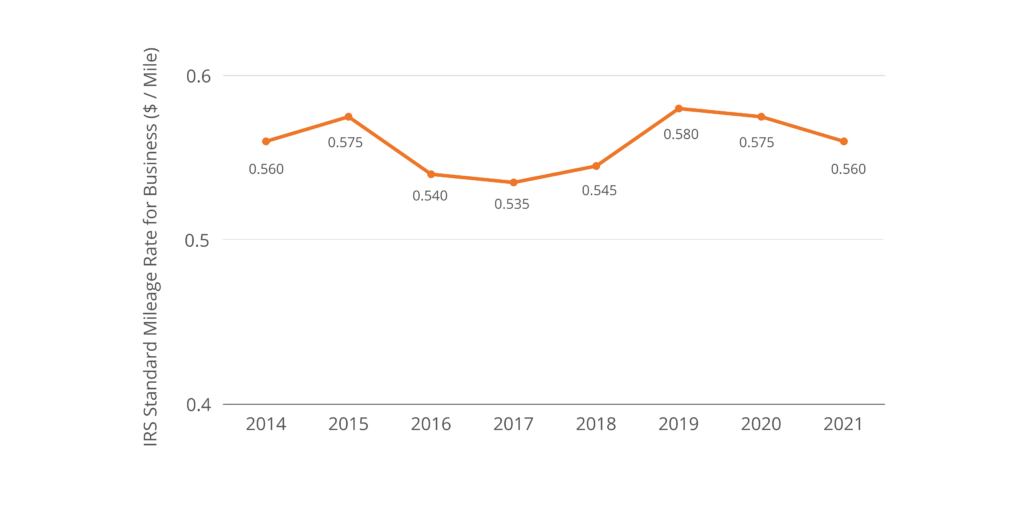The IRS standard mileage rate is usually announced in December for the upcoming tax year, and the number they land on can have a huge impact on the amount your business pays in expense reimbursement. As we enter the home stretch of 2021, the possibility of the IRS raising the standard mileage rate for 2022 is beginning to seem more and more real. To help you prepare yourself — and your budget — for next year, we’re reading the tea leaves of 2022 to see exactly what the next year has in store for us.
What Influences the IRS Mileage Rate?
Each year, the IRS analyzes how much it costs to own and operate a car in the US to calculate the standard mileage rate. A common misconception about the mileage rate is that it’s tied to gas prices. While the cost of gas is certainly a factor, a CompanyMileage analysis of what it really costs to own and operate a car found that fuel prices only account for 30% of the overall cost. Depreciation actually makes up the largest portion of vehicle ownership costs, accounting for 45%. Other costs include insurance (12%), licenses, registration and taxes (7%), and tires (3%) and maintenance (3%).
All of these assorted costs really start to add up for car owners. In 2021, the national average cost of owning and driving a vehicle hit $9666, according to AAA’s Your Driving Costs report, that’s up from $9561 in 2020 and $9282 in 2019. While these numbers can’t be directly compared due to AAA changing its methodology this year, it still points to a trend of increasing vehicle costs. Couple that with rising inflation and supply chain interruptions, and 2022 is shaping up to be an expensive year for owning and operating a vehicle in the US.
Rising Maintenance Costs Will Increase Insurance Rates
According to S&P Global Market Intelligence’s annual US Auto Insurance Market Report, the costs associated with repairing and replacing vehicles are increasing sharply due to a range of issues including labor shortages, supply chain interruptions and inflation. This will cause insurance companies’ underwriting profit margins to narrow significantly. In response, insurance companies are expected to increase rates. In fact, we’re already seeing this trend. According to data from Quadrant Information Services, the 2021 average car insurance rate is $1,592 for a good driver with good credit, up from $1,555 in 2020. In 2022, prepare for personal insurance premiums to go up, as well. According to S&P’s report, personal auto direct premiums will increase from 3.1% in 2021 to 5.4% in 2022.
Gas Prices Will Also Remain High
If you’ve filled up at the pump lately, then you know that gas prices have shot up this year. US regular gasoline retail prices averaged $3.18/gallon in September, almost a dollar higher than the same time last year. While these prices are expected to decrease, the national average is expected to remain above $3 for the remainder of the year. In 2022, the average is expected to hover around $2.74 according to the US Energy Information Administration (EIA).
To help you understand what this could mean for the standard mileage rate, CompanyMileage compared annual fuel prices against the IRS standard mileage rate to see how these two values have changed since 2014.


The last time a gallon of gasoline hovered near $2.74 was before the pandemic in 2018. For the next year, 2019, the IRS was prompted to increase the standard mileage rate to 58 cents per business mile driven. Does this mean the IRS will increase the rate in 2022 similarly? It’s hard to say exactly how much the rate will change, but it’s a safe bet to assume it will increase by at least two cents to reflect the increase in vehicle costs.
What Will the Impact Be?
You may be thinking that a few cents is not that big of a deal, but when you have to reimburse 2 more cents for each business mile your employees drive, it takes a bigger bite out of your budget than you might imagine. For instance, let’s say you have 100 employees, and they each drive an average of 5,000 miles each year. At the current rate of 56 cents, total reimbursement expenses amount to $280,000. If the rate is 58 cents, you pay $290,000. That’s an extra $10,000!
Control Employee Mileage Reimbursement Costs
As 2022 looms closer, it will be wise to prepare for increased reimbursement expenses accordingly. CompanyMileage helps companies keep these costs from getting out of hand. Our mileage and expense reimbursement software, SureMileage, enables you to eliminate costs associated with mileage inflation and inaccurate expense reporting.
Rather than tracking the miles employees drive and then verifying them after the fact, SureMileage calculates the mileage between the beginning and ending points of each trip. This method eliminates the potential for detours, non-work related errands and inflated mileage estimates from winding up in their trip logs.
It only takes a few minutes for employees to submit trips for reimbursement using the SureMobile app. Once submitted, our software takes trips through your approval process before a reimbursement for their travel is issued. SureMileage integrates with all major payroll and accounting systems, so the entire reimbursement process is seamless from start to finish.
No matter what the IRS standard mileage rate is in 2022, you want to be ready with expense reimbursement software that helps your company save money. Join the thousands of CompanyMileage’s customers who have saved up to 30% on reimbursement expenses today. Request a demo to learn more.